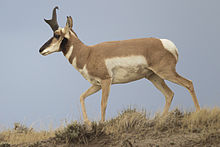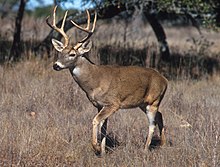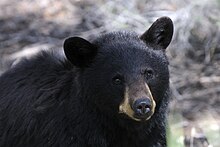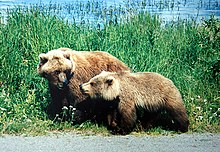Fauna of the United States
This article needs additional citations for verification. (May 2021) |
The fauna of the United States of America is all the animals living in the
An estimated 432 species of mammals characterize the fauna of the continental U.S. There are more than 800 species of bird is one of the most widely distributed hawks not only in the U.S., but in the Americas.
Huge parts of the country with the most distinctive indigenous wildlife are protected as national parks. In 2013, the U.S. had more than 6770 national parks or protected areas, all together more than 1,006,619 sq. miles (2,607,131 km2).
Western United States
The ecoregions and ecology found in the
The western continental coast of the U.S., just as the East Coast, varies from a colder-to-warmer climate from north to south. Few species live throughout the entire West Coast, however, there are some, including the
While the
Along the southwestern border there are
The
Channel Islands
The
Southern United States
The
The Southern United States is home to a multitude of reptiles and amphibians. The
Mammals of the region include the
Many water-dwelling mammals inhabit the South including the
There are over 1,100 species of bird in the Southern U.S. ranging from upland birds, to waterfowl. The South is home to many coastal birds including
Central United States

In the
Reptiles include
Rabbits live throughout the Great Plains and neighboring areas; the black-tailed jackrabbit is found in Texas, Oklahoma, Nebraska and Kansas, the white-tailed jackrabbit in the Dakotas, Minnesota and Wisconsin, the swamp rabbit in swampland in Texas, and the eastern cottontail is found in Texas, Oklahoma, Kansas, Nebraska, the Dakotas, and every state in the Eastern U.S.

The groundhog is widespread throughout Illinois, Iowa, Missouri, and Minnesota. Virginia opossum is found is states such as Missouri, Indiana, Iowa, Oklahoma, Nebraska and Kansas.
The

Maybe the most iconic animal of the American prairie, the American buffalo, once roamed throughout the central plains. Bison once covered the Great Plains and were critically important to Native-American societies in the Central U.S. They became nearly extinct in the 19th century, but have made a recent resurgence in the Great Plains. Today, bison numbers have rebounded to about 200,000; these bison live on preserves and ranches.[9]
Some of the species that occupy every central state include the
The
Eastern United States

In the Appalachian Mountains and the Eastern United States are many animals that live in forested habitats. They include deer, rabbits, rodents, squirrels, hares, woodpeckers, owls, foxes and bears. The New England region is particularly famous for its crab and the American lobster living along most of the Atlantic Coast. The bobcat, raccoon and striped skunk live in every eastern state, while the American alligator lives in every coastal state between North Carolina and Texas.
Some species of mammals found throughout the Eastern U.S. includes the red fox and gray fox, the North American beaver, North American porcupine, Virginia opossum, eastern mole, coyote, white-tailed deer, American mink, North American river otter, and long-tailed weasel. The American black bear lives throughout most of New England, New York, New Jersey, Pennsylvania, Maryland, the Virginias, and parts of the Carolinas and Florida.
Shrews are common: the cinereus shrew, long-tailed shrew and American water shrew are widespread in the New England region, while the North American least shrew and southeastern shrew are common in the southeastern states. The American pygmy shrew, smoky shrew, and northern short-tailed shrew are found from the Appalachian Mountains to New England. The star-nosed mole lives throughout the Eastern U.S., while the hairy-tailed mole is more common from the Appalachians to New England in the north.
Hares are also common: the
The
The
Of the marine life, the
The
Several sea turtles live along the Atlantic coast, including the

Some of the snake species found in much of the Eastern U.S. includes the
Snakes limited to the southeast includes the
is common throughout the Eastern United States, with the exception of New York and New England.The
Hawaiian Islands

Much of the fauna in
Famous birds include
live throughout most of the archipelago.In
Alaska

The
Alaska has also over 430 species of birds and the largest population of bald eagles in the nation. From pygmy shrews that weigh less than a penny to gray whales that weigh 45 tons, Alaska is the "Last Frontier" for animals as well as people. Many species endangered elsewhere are still abundant in Alaska.
Aleutian Islands
The
The islands are also frequented by vagrant Asiatic birds, including the
Territories
American Samoa

Because of its remote location, diversity among the terrestrial species is low. The archipelago has a huge variety in animals and more than 9,000 acres is a national park:
The mammals include several species of native bats, including the Samoa flying fox and insular flying fox. The avifauna includes 65 species of bird[21] where the more unusual distinctive ones are the blue-crowned lorikeet, the spotless crake, the many-colored fruit dove, the wattled honeyeater, tropical pigeons, the samoan starling, white tern, black noddy and the red-tailed tropicbird.[22]
There are many reptiles in the islands, including five species of geckos, eight species of skinks and two species of snakes: the
Guam
Shortly after World War II, the
Northern Mariana Islands
The Commonwealth of Northern Mariana Islands is home to 40 indigenous and introduced bird species. Some endemic bird species are the
.Puerto Rico

Puerto Rico has 349 bird species, 83 mammals, 25 amphibians, 61 reptiles and 677 species of fish. Birds found nowhere else on earth include for instance the
Virgin Islands
The
Articles by area
- Fauna of Alabama
- Fauna of Alaska
- Fauna of Arizona
- Fauna of Arkansas
- Fauna of California
- Fauna of Colorado
- Fauna of Connecticut
- Fauna of Delaware
- Fauna of the District of Columbia
- Fauna of Florida
- Fauna of Georgia
- Fauna of Hawaii
- Fauna of Idaho
- Fauna of Illinois
- Fauna of Indiana
- Fauna of Iowa
- Fauna of Kansas
- Fauna of Kentucky
- Fauna of Louisiana
- Fauna of Maine
- Fauna of Maryland
- Fauna of Massachusetts
- Fauna of Michigan
- Fauna of Minnesota
- Fauna of Mississippi
- Fauna of Missouri
- Fauna of Montana
- Fauna of Nebraska
- Fauna of Nevada
- Fauna of New Hampshire
- Fauna of New Jersey
- Fauna of New Mexico
- Fauna of New York
- Fauna of North Carolina
- Fauna of North Dakota
- Fauna of Ohio
- Fauna of Oklahoma
- Fauna of Oregon
- Fauna of Pennsylvania
- Fauna of Rhode Island
- Fauna of South Carolina
- Fauna of South Dakota
- Fauna of Tennessee
- Fauna of Texas
- Fauna of Utah
- Fauna of Vermont
- Fauna of Virginia
- Fauna of Washington
- Fauna of West Virginia
- Fauna of Wisconsin
- Fauna of Wyoming
Insular areas
- Fauna of American Samoa
- Fauna of Guam
- Fauna of the Northern Mariana Islands
- Fauna of Puerto Rico
- Fauna of the United States Virgin Islands
See also
- Animal welfare in the United States
- Flora of the United States
- Invasive species in the United States
Notes
- ^ This list is derived from the IUCN Red List which lists species of mammals and includes those mammals that have recently been classified as extinct (since 1500 AD). The taxonomy and naming of the individual species is based on those used in existing Wikipedia articles as of 21 May 2007 and supplemented by the common names and taxonomy from the IUCN, Smithsonian Institution, or University of Michigan where no Wikipedia article was available.
References
- ^ "United States | History, Map, Flag, & Population". Encyclopedia Britannica.
- ^ "Birds". Audubon.
- ^ "Number of Native Species in United States - Current Results". www.currentresults.com.
- ^ "NPS.gov Homepage (U.S. National Park Service)". www.nps.gov.
- ^ "Yellowstone Fact Sheet - Yellowstone National Park". Archived from the original on June 2, 2013.
- ^ "Rattlesnake facts". Archived from the original on July 21, 2013. Retrieved September 16, 2014.
- ^ C. Michael Hogan. 2008. Torrey Pine: Pinus torreyana, Globaltwitcher, ed. Nicklas Stromberg [1] Archived 2012-05-25 at the Wayback Machine
- ISBN 9781402756238.
- ^ a b "American Bison | National Geographic". Animals. May 10, 2011. Archived from the original on April 13, 2021.
- ^ ISBN 9780801434754.
- ^ ISBN 9780801874161.
- ^ "Northeast Region, U.S. Fish and Wildlife Service". www.fws.gov. Archived from the original on July 28, 2020. Retrieved May 11, 2021.
- ^ "USFWS: Extinct Species". www.fws.gov.
- . Retrieved January 15, 2020.
- ^ a b "Hawaii fauna - the Hawaiian animals". www.to-hawaii.com.
- ^ "Turtles in the Hawaiian Islands". Archived from the original on January 30, 2013. Retrieved April 7, 2013.
- ^ "Hawaii Animals!".
- ^ "Travel Alaska - Southwest Alaska - the Aleutian Islands".
- ^ "Buldirbirds". Archived from the original on October 17, 2014. Retrieved August 27, 2017.
- ^ a b "Campaign". Oceana.
- ^ Watling, Dick (2001) A Guide to the Birds of Fiji & Western Polynesia, Environmental Consultants (Fiji), Suva
- ^ "Marine & Wildlife Topics" (PDF). Retrieved May 11, 2021.
- ^ a b "List" (PDF). www.nps.gov. Retrieved May 11, 2021.
- ^ a b "NOAA CoRIS - Ecosystem Essays: Guam - Terrestrial Fauna of Guam". Archived from the original on November 11, 2013. Retrieved July 10, 2013.
- ^ a b Brad Lendon (February 28, 2013). "Deadly mice to rain down on Guam snakes". CNN.
- ^ "Podróże - Kobieta.pl". Archived from the original on September 12, 2012. Retrieved July 10, 2013.
- ^ "Animals and Plants Unique to Puerto Rico". lntreasures.com.
- ^ John, Mailing Address: 1300 Cruz Bay Creek St; Us, VI 00830 Phone:776-6201 x238 Headquarters/Visitor Center phone contact Information Contact. "Animals - Virgin Islands National Park (U.S. National Park Service)". www.nps.gov.
{{cite web}}: CS1 maint: numeric names: authors list (link) - ^ "Sea Turtles of the U.S. Virgin Islands". Archived from the original on April 9, 2013.
